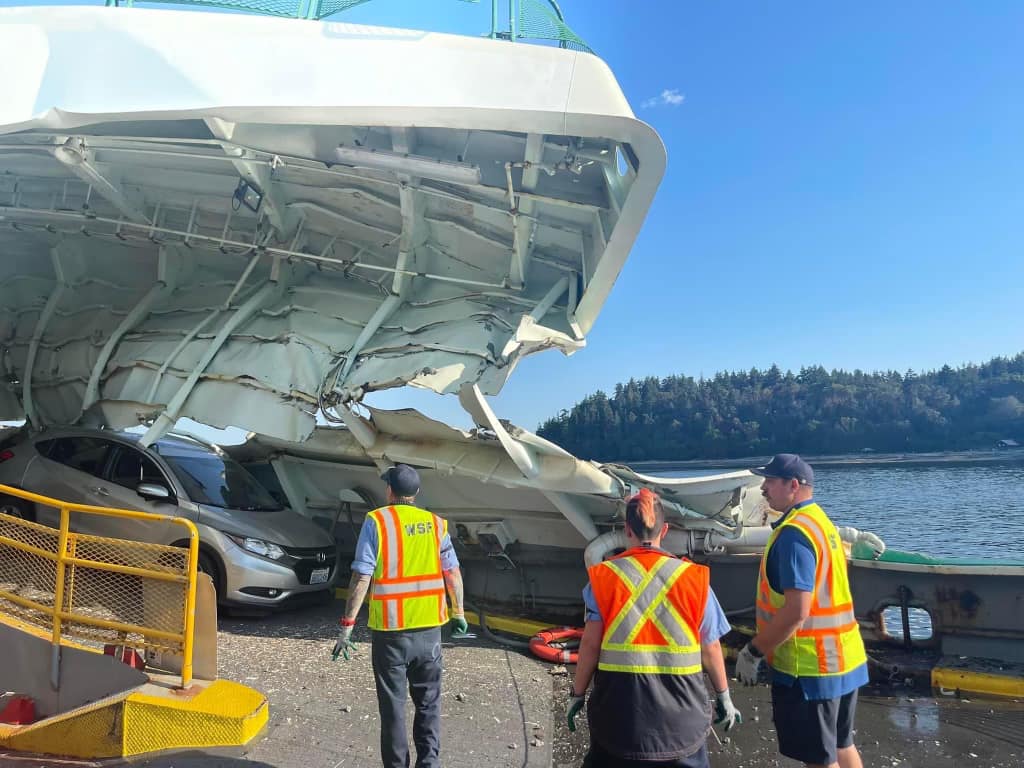By Andy Valencia
When our Cathlamet ferry crashed into a dolphin pier on July 28, 2022, we were told three things in short order. First, all crew had passed drug tests after the accident. Second, the following day, the captain resigned. Third, the USCG – United States Coast Guard – would lead the investigation and determine why the crash happened.
For a sense of proportion, the 1986 Challenger shuttle disaster investigation identified the cause and issued their report in about 5 months. For the Cathlamet, after 8 months, the USCG has produced no report. For some reason, WSF – Washington State Ferries – instead published the results of their own investigation.
The report is awash in details that do not answer the central question: What failed, and how will WSF fix it?
For the core question, we know that, after dolphin impact, the captain asked, “What happened?” The captain then passed a drug test, lawyered up, and has responded to no subsequent questions. The only other person present in the pilothouse was a “quartermaster,” a position subordinate to the vessel’s captain. The quartermaster indicated they were reading a document, and were not aware of the captain or the vessel’s operation until the dolphin impact.
The report recommended better training, the installation of a Voyage Data Recorder system, and while not a part of the report, was accompanied by an announcement that mentioned the possibility of new “psychometric” tests for vessel captains.
With my background in software development and networking protocols, I’m accustomed to a two-step approach to catastrophic failures. The first is “root cause analysis,” where you determine precisely what led to the failure. The remedies are then evaluated with respect to the failure: Are they relevant? Are they comprehensive? Are they feasible?
Through this lens, the report is puzzling. A major roadblock is the captain’s silence, behind the double barriers of resignation and legal counsel. Wouldn’t it be desirable to make legal and procedural changes so that future catastrophic events can be investigated efficiently?
The Fifth Amendment certainly protects anyone from being forced to testify against themselves. Since the effectiveness of the investigation is compromised without the captain’s information, why wasn’t the captain offered legal immunity? With his own legal status protected, a subpoena might compel testimony.
The “psychometric” test was mentioned, but not included in the report itself. What data from the investigation caused WSF to mention it during the report’s release? Why did they choose to highlight this, as opposed to, say, medical conditions, medications, and recent medical events in the captain’s history? If psychometric tests are relevant, why are they not in the report? If any medical factors are relevant, isn’t it critical to identify them in case other WSF personnel are at risk?
The report is also oddly incurious about the state of the captain. Post-accident, he was noted only as seeming to be “in shock.” Could he walk in a straight line? Did his eyes track? Was his speech slurred? How was his apparent sense of balance?
Were the captain’s and quartermaster’s cell phone activities subpoenaed? An infamous rail crash was caused by distraction on the part of the engineer as he texted. Why was this aspect not investigated, even if to check it off as a verified negative?
Is there really no system to alert when a ferry is going too fast when it’s too close to the shore or dock? GPS-based terrain alerts are a commodity often present in even the smallest general aviation airplanes.
While the report recommends Voyage Data Recorders for all ferries (and one was installed in the Cathlamet during its repairs), the only aspect of this which applies to the current investigation is audio recording. Hearing for ourselves “what happened?” is much less helpful than a video record. What was the captain doing? Slumped? At the controls? Stiffly frozen? Why does the report not discuss video as a part of the remedies?
The unsettling conclusion of this investigation of the Cathlamet crash is that the underlying cause remains unknown. In safety engineering, if you don’t know why something happened, you don’t know if you’ve fixed it. Investigations can be embarrassing to the organization under scrutiny, so the USCG’s involvement as the lead agency was sensible. Yet our Coast Guard is silent, and WSF is left to report on itself.
If we’re lucky, the shotgun remedies in this report will address it. If we’re not, there could be more investigations in our future.
At the time of going to print, neither WSF, nor the USCG, nor the National Transportation Safety Board have responded to any of our queries concerning these details.

